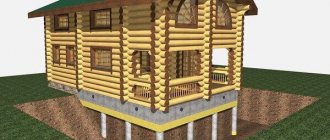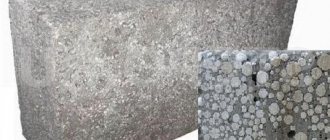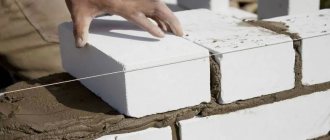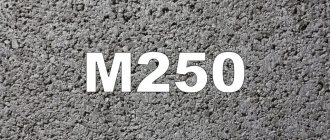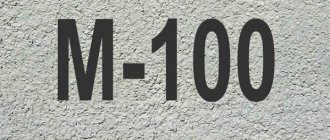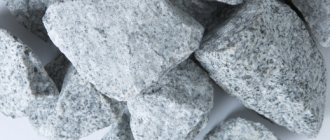There is a large selection of concrete grades on sale, which in turn are divided into classes. Building materials have different composition, density and areas of use. The article will focus on such building material as concrete M 200 class B15. According to its basic properties, sand concrete mixture M 200 belongs to the type of heavy concrete. All classes up to M 150 are used for the preparatory stage in repair work, these include: pouring the foundation base, monolithic structures and reinforced concrete slabs. It is also used in the construction of concrete paths that will bear moderate loads.
Variety of concrete M 200
There are such subtypes of composition that have different components and properties:
- Used:
- in domestic construction;
- during the construction of industrial buildings.
- Type of binding building material included:
- cement;
- silicate;
- gypsum;
- adding polymer elements.
- By dimensions of solid filler:
- coarse-grained;
- fine-grained.
- Quality of density and elasticity of constituent particles:
- dense;
- porous;
- mixtures for special purposes.
- The rate of hardening, the autoclave mixture is designed to compact under natural temperature conditions.
- Volumetric weight indicators:
- heavy;
- lightweight.
Class B 15 concrete, what brand is this? In modern construction technologies, the strength indicator has been replaced by a more accurate classification “B”. Class B 15 is a popular construction grade M 200, which is considered ordinary.
Concrete heavy class 15 m200 – strength gain
Hydration of cement in the concrete mixture occurs gradually and is completed four weeks after class B15 concrete is poured. By this time, the building material acquires operational strength, allowing further construction work to be carried out and the monolith to be subjected to loads.
The intensity of hardening is influenced by the following factors:
- temperature conditions. The optimal temperature for normal hardening is 18–20 degrees Celsius;
- moisture concentration in the air. In dry and hot weather, the surface must be moistened periodically;
- wind. The rate of moisture evaporation increases in windy weather. To maintain moisture in the hardening mass, it is moistened.
Concrete B15 M200 for foundation
Technical features
Heavy class concrete B 15 M 200 has design features that are specified in the current GOST standards. Cement mortar is able to organize the strength indicators of the finished structure, the manufacturing recipe and the proportions of the composition, the coefficients of elasticity, density, design compression resistance, and the specific gravity of a cubic meter of mortar. The main characteristic of the finished structure is compression resistance, which is indicated by the letter “M” and the brand number.
Concrete B 15 strength class M 200 with average nominal strength. Indicators of solution quality, maximum strength and density are achieved after 28 days. The composition of the cement mortar includes crushed stone of various types - gravel, granite, lime with a fraction of 6 to 70 mm.
For the construction of monolithic structures, according to GOST, it is allowed to use crushed stone and gravel with dimensions up to 14 cm. Solid fillers must exceed the strength and design resistance by 2 times. Coarse-grained aggregate is used to create structural frames for houses made of reinforced concrete. The recipe for preparing the composition should include sand with a fraction of 0.15 to 5 mm. Fine filler with a density of 1790 kg/m3. Sand concrete mixture M 200 with calculation data for compression resistance of 200 kg/m3.
In order for work on large objects to proceed faster, non-fine gravel or crushed stone is added to heavy class concrete of 15 m200; the aggregate size should be 20 - 140 millimeters. The main feature of concrete mortar is its compression resistance Rbn, which is marked with the letter “M” with a number. The specific gravity of 1 m3 of concrete B 15 M 200 ranges from 1800-2500 kilograms. The mass of the composition varies depending on the density of all components and is in the range of 300-3000 kg.
Composition and proportions
Like all others, concrete grade B15 M200 consists of a binder - cement, aggregates - sand and crushed stone. All these components are mixed and diluted with clean water to form a batter or thick sour cream. In general, the density may vary depending on the requirements. For example, formwork with reinforcement requires a more fluid composition, since the solution must fill the space between the reinforcing rods.
Concrete M200 - proportions for cement M400 and M500
The tables show only dry ingredients. Water is added based on the required hardness of the solution. The average water-cement ratio is 0.6. This means that water should be taken 0.6 by weight of cement. To put it simply, add 600 ml of water per 1 kg of cement. To begin with, you should measure out this amount. Add half of it to the concrete mixer at once, then in small portions until the desired consistency is reached. As a result, there may be a little more or a little less water. Even the humidity of the sand affects its quantity.
The composition of concrete grade 200 in the table is given both in mass fractions and in volume fractions. When purchasing, it is more convenient to handle kilograms, and they are usually poured into a concrete mixer with buckets or shovels. Volume fractions are more useful here.
GOST standards
Heavy class concrete B 15 M 200 is described with its features in the standards GOST 7473-2010 BST V15, P3, F100, W 6.
The M 200 marking indicates such qualities
- F 100 – frost resistance. When the mixture is subject to freezing and thawing about a hundred times, the material will lose its quality by 5%;
- W 6 - the water resistance of the composition indicates that it prevents the penetration of water at pressure levels of up to 0.6 atm;
- P 3 suggests that mobility will depend on the proportionality of water and cement.
Quality control
JSC "ABZ KAPOTNYA" controls the quality of products throughout the entire process, from the selection of raw materials to the finished concrete mixture. The production laboratory is an independent structural unit of JSC "ABZ KAPOTNYA" and has the status of a quality control service for raw materials, finished products, as well as research work in the field of new technologies. The production laboratory carries out incoming, operational and acceptance control of raw materials and finished products, as well as control of the composition of concrete mixtures for compliance with GOST, TU and other regulatory documentation.
Components of concrete M 200
Concrete grade M 200 is a compound of low composition due to the content of fast-acting, hydrophobic, sulfate-resistant, plasticized cement elements. Technical features do not provide for the introduction of any additive including active minerals.
In frequent variants, elements with surface-active properties are added to it. These particles will make the mixture plastic, frost-resistant or quick-drying. It is because of such additives that concrete M 200 V 15 is used in regions with temperature fluctuations or on construction sites where work needs to be completed in a short period of time.
According to the quality certificate, concrete M 200 B 15 must contain cement, sand, water and coarse aggregate. An example of selecting the proportions of the elements included in the M 200 brand:
- water – 0.18 m3;
- cement mortar – 0.25 m3;
- sand or other filler – 0.45 m3;
- coarse fractional filler - crushed stone, gravel and others amount to 0.9 m3.
Such proportions of the components included in the composition are suitable for obtaining 1.76 cubic meters of the finished mixture of the required elasticity. Each special case, like the example above, must be considered individually, since the number of components of each cubic meter may vary, but the proportions must be observed. Recommendations for the use of a composition of any brand are indicated by the manufacturer on the packaging.
The composition of concrete B 15 must be strictly regulated with proportions: for cement mortar M 400 - 1 to 2.8 to 4.8 to 0.5 and for cement grade M 500 - 1 to 3.5 to 5.6 to 0.5 .
A high-quality product is obtained through the use of element selection techniques. It is recommended to draw up a map for selecting a concrete component for class B 15 (15 MPa), using Portland cement M 400, purified sand, with a density of 2600 kg/m3, granite crushed stone with filler parameters of 20 mm and a bulk density of 1400 kg/m3. Using a special formula, which is obtained experimentally, the required amount of water is determined. The dimensions of the gravel material are determined by sets of sieves that have holes with diameters of 7, 4, 2, 1 and 0.5 cm.
Heavy concrete, aggregate size 40 mm, class B 15 M 200 can contain the following types of crushed stone:
- Gravel.
- Granite.
- Limestone.
For beams with a width of 20 cm, you can use gravel with a stone diameter of no more than 15 cm. Sand and crushed stone fractions are used in accordance with GOST standards.
Concrete B15: what it represents, detailed characteristics
Forming concrete B15
Concrete B15 grade M200 is practically a panacea on the construction site of any project. Factories pour prefabricated reinforced concrete from mixtures of this class, which is not intended for load-bearing structures.
When working independently on your site, this brand is also often used. Before the “massive” use of the B15 mixture, you need to know all its characteristics, which can be examined “under a microscope” in our publication.
Application area
The concrete mixture M 200 V 15 is universal, it is used in various areas of repair and construction work in various fields:
- Pouring concrete screed. This work is carried out indoors, for this reason the composition may not have increased resistance to temperature changes and a humid environment. It is necessary to take into account the fact that such a base must withstand the load. For this reason, the finished elements are strong and dense.
- Hydraulic concrete based on sulfate-resistant Portland cement, class B 15 M 200, is used in the construction of houses that are in contact with the ground.
- Foundations for domestic and industrial facilities. Such compositions have good compression resistance, which will support the weight of the entire structure. Before starting work, you should calculate the specific gravity of the finished building.
- Fine-grained concrete class B 15 M 200 is used for the construction of street parking lots and basement residential floors.
- Reinforced concrete structures, stairs, floors, columns. The reasonable cost of concrete with a strength of B 15 has excellent elasticity characteristics, which allows the finished structure to withstand heavy loads.
- Construction of paths, blind areas, platforms and other similar objects. The specific gravity of the load on such structures is not very large. For this reason and given the low cost, this mixture is suitable for the type of work listed above.
- Heavy concrete, aggregate size greater than 40 mm, class B 15 M 200 is used in the construction of road slabs. Taking into account the low cost, this solution is used for the construction of slabs made of reinforced concrete materials. The weight of the load on the slab base must also be taken into account. Plus, it is recommended to add products that increase the density of the mixture. In accordance with the documentation “heavy concrete class B 15 M 200”, GOST is valid. Such additives are added per 1 m3 of solution. The manufacturer must indicate on the packaging how much of the additive should be added per cubic meter of the mixture to obtain a particular elasticity of the material.
- Heavy concrete for hydraulic structures, class B 15 M 200, allows you to build houses on wet soil, dams, bridges, dams, hydraulic structures.
Concrete m200 with frost resistance f150, water resistance w6 is used in monolithic construction if the building does not exceed a height of 5 floors.
Advantages and disadvantages of concrete grade M200 (B15)
We described where concrete M200 (B15) is used. Now you will learn about the advantages and disadvantages of this brand.
The advantages of concrete M200 (B15) include:
- Average strength It fully satisfies the requirements of private developers.
- High water resistance Thanks to this quality, the brand can be used in drainage systems, septic tanks, when equipping ponds, fountains, and small yard pools.
- Good frost resistance Concrete M200 (B15) is advantageous to use as a material for landscaping and making outdoor furniture. Products and objects are durable and do not collapse for several decades.
- High plasticity This material is easy to work with and quickly fills containers. Products of any shape are made from concrete.
- Possibility of using different fillers Without loss of strength, small and large crushed stone, gravel, expanded clay and even recycled materials (slag, broken concrete or brick) can be used as filler.
- There are two variations in water resistance and frost resistance. By slightly changing the ratio of components it is easy to obtain a material that will better repel water and withstand temperature changes.
- Low cost M200 (B15) costs less than higher brands.
The disadvantages of the M200 brand include:
- Limited scope of application The strength of the material is not enough to make foundations from it for houses with several floors, large buildings, to use it for the top layers of road surfaces and most types of reinforced concrete products.
- Price The cost of this variety is higher than M50-M150 concrete. Therefore, for some types of work (bases under foundations, borders, home furniture) it is not very profitable to use it.
As you may have noticed, the M200 brand (class B15) has more advantages than disadvantages. If you choose the right way to use it, you can get a durable product at an affordable price. You can make this type of concrete yourself if you are going to pour a yard or garden path. But for foundation equipment, it is better to order material from the factory. Then the strength and quality of concrete will be guaranteed.
Advantages
- The mortar is universal and therefore it is often used by both private builders and industrial facilities, due to the maximum ratio of mechanical properties, reasonable cost and quality.
- If we compare the expanded clay concrete mixture M 200 with similar low-class compositions, it comes with high calculated compressive resistance data.
- High frost resistance characteristics.
- The low thermal conductivity of the building material allows you to retain heat inside a room made of reinforced concrete without installing an additional thermal insulation layer.
- A mixture with this marking quickly becomes strong and dense, this will allow you to carry out repair and construction work with maximum speed.
- The formation of cracks during construction is reduced to zero.
- The working temperature of the solution is from +5 to +350 degrees. The addition of frost-resistant agents in certain proportions is used at subzero temperatures.
Concrete class M200 - the main advantages of application
The advantages of using two hundredth mortar, which is a universal building material:
- expanded scope of application. Concrete composition is in demand for the construction of industrial facilities and solving problems in private households;
- acceptable price. The use of an inexpensive solution allows you to reduce the total cost of construction activities;
- improved adhesion to the reinforcing surface. The mixture is in good contact with the metal, which increases the strength of reinforced concrete structures;
- reduced thermal conductivity. It allows you to reduce the cost of maintaining a comfortable temperature and reduce the cost of purchasing insulation;
- resistance to high temperatures and open fire. The structure and properties of the material do not change in a fire hazardous situation;
- durability. A properly prepared mixture, after hardening, turns into a monolith that does not collapse during the period of operation.
Minuses
Brand M has at least 200 negative qualities. Basically this is a low waterproof rating. The proportions of added water must be observed with particular precision. Of the total composition, its weight is 20%.
According to GOST documentation and the quality certificate, heavy class B 15 M 200 concrete should not be used for houses that will exceed more than 5 floors. Also, the weight of the finished building is not taken into account.
Concrete M 200 BST V 15 P 3- P 4 F100 W 4, although it is considered a low-grade mortar, this does not make it any less in demand. The mixture has good strength properties for laying load-bearing walls, pouring monolithic foundations, floors and paths. It is easy to work with such building materials, because during production all standards and rules for the components were strictly observed. Good strength and durability of the finished elements, plus a reasonable price - these are the main advantages over other brands.
Concrete class M200 - the main advantages of application
The advantages of using two hundredth mortar, which is a universal building material:
- expanded scope of application. Concrete composition is in demand for the construction of industrial facilities and solving problems in private households;
- acceptable price. The use of an inexpensive solution allows you to reduce the total cost of construction activities;
- improved adhesion to the reinforcing surface. The mixture is in good contact with the metal, which increases the strength of reinforced concrete structures;
- reduced thermal conductivity. It allows you to reduce the cost of maintaining a comfortable temperature and reduce the cost of purchasing insulation;
- resistance to high temperatures and open fire. The structure and properties of the material do not change in a fire hazardous situation;
- durability. A properly prepared mixture, after hardening, turns into a monolith that does not collapse during the period of operation.
Calculation of concrete composition
Need to get:
Brand (class) of concrete Select the brand (class) of concrete you want to receive.
M100 (B7.5) Due to its low strength, it is mainly used for preparatory concrete work.
Can be used as a “pillow” under a foundation, curb, paving slabs, road surface, etc.
M150 (B12.5) Concrete of this grade has sufficient strength for pouring various types of foundations for small structures. Also used for pouring floor screeds and laying concrete paths.
M200 (B15) One of the most popular grades of concrete (along with M300) used in suburban construction. Main application: pouring foundations (pile-grillage, strip, slab), making concrete paths, walls, stairs.
M250 (B20) Used for pouring foundations, light-loaded floor slabs, making stairs, retaining walls.
M300 (B22.5) Along with M200, it is very popular in private construction. Due to its versatility, this brand of concrete allows it to be used for pouring the foundation for almost any house in the countryside, as well as for making fence strips and floor slabs.
M350 (B25) Main application: production of floor slabs, load-bearing walls, columns, reinforced concrete products and structures, casting of monolithic foundations.
M400 (B30) Rarely used in suburban construction. It is used for the manufacture of transverse beams, retaining walls, bridge structures and hydraulic structures, pouring pool bowls, and basement floors of monolithic buildings.
M450(B35) Main application: bank vaults, bridge structures, metro construction, hydraulic structures.
M550 (B40) Main application: reinforced concrete structures for special purposes (storage facilities for banks, dams, dams, metro construction).
M600 (B45) Main application: foundations for complex and large-scale objects, bridge supports, hydraulic structures, special-purpose objects (bunkers, etc.).
Mix Workability Select the workability (hardness) of the concrete mix.
Based on workability, concrete mixtures are divided into flexible and rigid. The class of mobility and rigidity is determined by the draft of the cone. Mobility is determined in cm, stiffness in seconds.
Zh1 (5-10sec) | Zh2 (11-20sec) | Zh3 (21-30sec) | Zh4 (31sec or more)
P1 (OK 1-4cm) | P2 (OK 5-9cm) | P3 (OK 10-15cm) | P4 (OK more than 16cm)
Zh1-Zh4 - concrete of this rigidity is used in road construction and in the manufacture of certain reinforced concrete products.
P1-P2 - used in the production of wall and foundation blocks, reinforced concrete products, paving slabs, paving stones, etc.
P3-P4 - mobility of concrete mixture, which is mainly used in private construction when pouring foundations, stairs, slabs, beams, columns, etc.
P5 - these concrete mixtures are called cast (like P4) and are used for supplying concrete with a concrete pump to a great height, as well as for pouring structures with a large content of reinforcement and embedded parts.
We have:
Change the bulk density of cement



